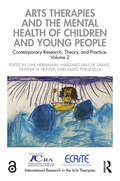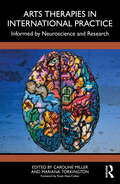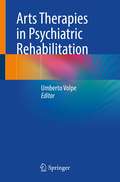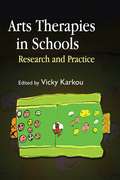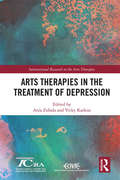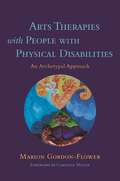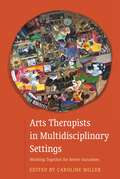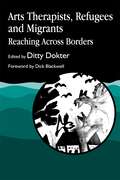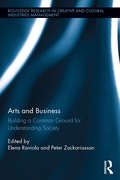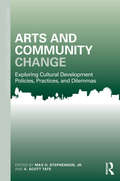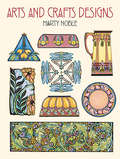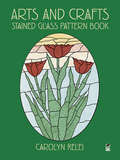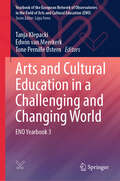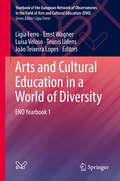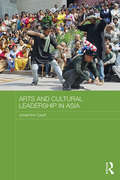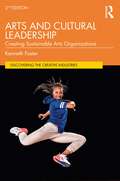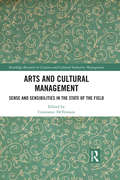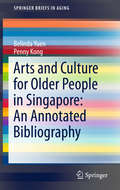- Table View
- List View
Arts Therapies and the Mental Health of Children and Young People: Contemporary Research, Theory, and Practice, Volume 2 (ISSN)
by Salvo Pitruzzella Uwe Herrmann de Zárate, Margaret Hills Heather M. HunterThis second volume expands and develops the discussion on arts therapies begun in volume one on the field’s relationship with children and young people’s mental health, demonstrating further contemporary research within international contexts.The book responds to a resounding call to address children and young people’s mental health. It explores a unique mix of diverse arts modalities including art, music, dance, expressive arts, and drama, creating opportunities for discourse and discussion of how the different arts therapies cohere and relate to each other. Chapters are truly global in approach, ranging from schools in India to children’s hospices in the United Kingdom, refugee transit camps in Greece, and residential care programmes for LGBTQ+ youth in the United States. Discussions from Greece and Taiwan, and innovative research from Israel, Norway, and Scotland are also featured with reference to diverse social, political, and cultural contexts. Ultimately, chapters prioritise the links between research, theory, and practice, providing accessible and implication-led dialogue on contemporary issues.This book provides new insights into the expanding field of the arts therapies and will be of great interest to arts therapists as well as academics and students in the fields of arts therapies, social work, psychotherapy, health psychology, and education.
Arts Therapies in International Practice: Informed by Neuroscience and Research
by Caroline Miller Mariana TorkingtonArts Therapies in International Practice: Informed by Neuroscience and Research brings together practice and research in the arts therapies and in neuroscience. The authors are all arts therapists who have reviewed their practice through the lens of modern neuroscience. Neuroscience confirms the importance of embodiment, choice, and creativity in therapy with a range of clients. Arts therapies directly provide these. The authors demonstrate how the arts therapies can be adapted creatively to work in different social and ethnic communities, with different ages and with different states of health or ill health. Although there is diversity in their practice and country of practice, they reaffirm key concepts of the arts therapies, such as the importance of the therapeutic relationship, and the key role played by the arts modality with its effects on the brain and nervous system. This book will appeal to a wide readership, including arts therapists, expressive arts therapists, a range of other psychotherapists and counsellors, students and their teachers, and those interested in the neuroscience of human development.
Arts Therapies in Psychiatric Rehabilitation
by Umberto VolpeThis book explores possible approaches to and uses of art therapy in mental health settings. Reflecting the latest scientific evidence, it represents a major step toward the harmonization of practices in the field, filling the gap between the theory and practice of art therapy. The book is divided into four major sections, corresponding to the main artistic domains: visual art therapy, music therapy, dance movement therapy, and drama therapy. Gathering the research and insights of leading professionals from around the globe, the book offers a diverse and balanced mix of perspectives. Accordingly, it will appeal to a broad readership including psychiatrists, psychologists, social workers, occupational therapists, psychiatric rehabilitation technicians, nurses, educators, art therapists, and students.
Arts Therapies in Schools
by Edited by Vicky KarkouAs arts therapists are increasingly working in schools, there is growing interest in identifying applicable therapeutic approaches and expanding on relevant research evidence. This book outlines the potential uses of music, art, drama and dance movement therapies in educational settings, and the contribution they have to make to the emotional and social development of children and adolescents. Drawing on international evidence, the book outlines a wide range of innovative applications of arts therapies across a range of settings, including mainstream classrooms, special schools and student support units. Examples of subjects covered include solution-focused brief dramatherapy groupwork in mainstream education, art therapy for children with specific learning difficulties who have experienced trauma and music therapy in special education. Particular emphasis is placed upon collaborative work, whether it be between arts therapists from different disciplines, arts therapists and teaching staff or arts therapists and researchers. Arts Therapies in Schools will be of great interest to arts therapists, and will also be useful to others who want to know about the potential of arts therapies in the classroom, including teachers and other education professionals, health professionals, educational psychologists, school counsellors and policy makers.
Arts Therapies in the Treatment of Depression (International Research in the Arts Therapies)
by Vicky Karkou Ania ZubalaArts Therapies in the Treatment of Depression is a comprehensive compilation of expert knowledge on arts therapies’ potential in successfully addressing depression. The book identifies ways of addressing the condition in therapy sessions, shares experience of tools and approaches which seem to work best and guides towards a conscious and confident evidence-based practice. Including contributions from international experts in the field of arts therapies, the book presents some of the most recent, high-profile and methodologically diverse research, whether in the form of clinical trials, surveys or case studies. The three sections of this volume correspond to particular life stages and explore major topics in arts therapies practice and the nature of depression in children, adults and in later life. Individual chapters within the three sections represent all four arts therapies disciplines. The book hopes to improve existing arts therapies practice and research, by encouraging researchers to use creativity in designing meaningful research projects and empowering practitioners to use evidence creatively for the benefit of their clients and the discipline. Arts Therapies in the Treatment of Depression is an essential resource for arts therapies researchers, practitioners and arts therapists in training. It should also be of interest to other health researchers and health professionals, particularly those who work with clients experiencing depression and in multidisciplinary teams.
Arts Therapies with People with Physical Disabilities: An Archetypal Approach
by Marion Gordon-FlowerFor those with mobility and communication challenges, arts therapies can be especially significant and rewarding as a means of self-expression and engaging with others. This book provides practical guidance on multimodal and archetypal arts therapy approaches adapted specifically for a physical disability context. Practical strategies and interventions are given, alongside case studies from individual and group arts therapy sessions. The author acknowledges the challenges of working with clients with physical disabilities, such as physical assistance in using resources, subtleties in communication of preferences and the need for extra members of staff, and gives clear guidance for accessible and effective sessions. This is essential reading for any arts therapist wanting a tailored approach to meeting the needs of people with physical disabilities, with a focus on person-centred and strengths-based methods. In addition, all frameworks covered are also adaptable for other client groups.
Arts Therapists in Multidisciplinary Settings: Working Together for Better Outcomes
by Caroline Miller Steve Harvey Mariana Torkington Robin Barnaby Abigail Raymond Marion Gordon-Flower Alison Talmage Tosca Lammerts Van Bueren Heather Fletcher Lucy-Mary Mulholland Agnès Desombiaux-Sigley Adrian Zygmu Lania Keryn Squires Jennie Halliday Judy Donovan Shari Storie Neetu Sharma Anaia Treefoot Megan SpraggIn a multidisciplinary setting or team, competing perspectives and principles can be challenging to negotiate, but supportive working relationships and effective collaboration can ultimately lead to an enriched experience and innovative outcomes for both professionals and clients. Drawing on their diverse experiences, art, music, drama, play and dance therapists emphasise the valuable results that their respective disciplines can produce when applied in settings ranging from schools to hospices, in collaboration with behaviour therapists, teachers, occupational therapists, speech therapists and other practitioners. The book provides a unique perspective on the common issues faced by arts therapists when working with other professionals and will assist arts therapists in promoting their profession to co-workers and clients.
Arts Therapists, Refugees and Migrants: Reaching Across Borders
by Ditty DokterThe legal and humanitarian response to the world's growing population of refugees and migrants has created more awareness of not only the physical but also the psychological needs of displaced peoples. Refugees are often the forgotten victims of war violence and political upheaval, subjected to the traumatic loss of family and home and the consequent deterioration of cultural identity as they seek asylum in other countries. Ditty Dokter is joined by contributors from a number of multicultural backgrounds, in a volume examining the issues surrounding intercultural arts therapies as a means of working with clients who are refugees and migrants. The role of art, music, dance, and drama in healing the effects of trauma and restoring the sense of cultural and personal identity is discussed, emphasising the need for sensitivity to cultural differences in practice. The ultimate aim is to promote more awareness of intercultural issues in an attempt to build a broader framework for arts therapy practice.
Arts and Aesthetics in a Globalizing World (Association Of Social Anthropologists Monographs)
by Raminder Kaur Parul Dave-MukherjiThis is an investigation of arts and aesthetics in their widest senses and experiences, presenting a variety of perspectives which range from the metaphysical to the political. Moving beyond art as an expression of the inner mind and invention of the individual self, the volume bridges the gap between changing perceptions of contemporary art and aesthetics, and maps globalizing currents in a number of contexts and regions.The volume includes an impressive variety of case studies offered by established leaders in the field and original and emerging scholarly talent covering areas in India, Nepal, Indonesia, Iran, Russia, Rwanda, and Germany, as well as providing transnational or diasporic perspectives. From the contradictory demands made on successful artists from the south in the global art world such as Anish Kapoor, to images of war and puppetry created by female political prisoners, the volume compels creative and political interpretations of the ever-changing and globalizing terrain of arts and aesthetics.
Arts and Business: Building a Common Ground for Understanding Society (Routledge Research in the Creative and Cultural Industries #6)
by Peter Zackariasson Elena RaviolaArts and Business aims at bringing arts and business scholars together in a dialogue about a number of key topics that today form different understandings in the two disciplines. Arts and business are, many times, positioned as opposites. Where one is providing symbolic and aesthetic immersion, the other is creating goods for a market and markets for a good. They often deal and struggle with the same issues, framing it differently and finding different solutions. This book has the potential of offering both critical theoretical and empirical understanding of these subjects and guiding further exploration and research into this field. Although this dichotomy has a well-documented existence, it is reconstructed through the writing-out of business in art and vice versa. This edited volume distinguishes itself from other writings aimed at closing the gap between art and business, as it does not have a firm standpoint in one of these fields, but treating them as symmetrical and equal. The belief that by giving art and business an equal weight, the editors also create the opportunity to communicate to a wider audience and construct a path forward for art and business to coexist.
Arts and Community Change: Exploring Cultural Development Policies, Practices and Dilemmas (Community Development Research and Practice Series)
by Max O. Stephenson Jr. Scott TateArts and Community Change: Exploring Cultural Development Policies, Practices and Dilemmas addresses the growing number of communities adopting arts and culture-based development methods to influence social change. Providing community workers and planners with strategies to develop arts policy that enriches communities and their residents, this collection critically examines the central tensions and complexities in arts policy, paying attention to issues of gentrification and stratification. Including a variety of case studies from across the United States and Canada, these success stories and best practice approaches across many media present strategies to design appropriate policy for unique populations. Edited by Max Stephenson, Jr. and A. Scott Tate of Virginia Tech, Arts and Community Change presents 10 chapters from artistic and community leaders; essential reading for students and practitioners in economic development and arts management.
Arts and Crafts Designs (Dover Pictorial Archive)
by Marty NobleInspirational, practical source of 125 superb, royalty-free illustrations for use by graphic artists and designers. Masterfully adapted from textiles, wallpaper, and other authentic sources, the motifs depict florals and insects etched into glassware, garlands of flowers in square and circular configurations, dragonflies adorning decorative bowls and platters, and much more.
Arts and Crafts Stained Glass Pattern Book
by Carolyn ReleiInspired by the elegant simplicity of the Arts and Crafts movement, this compilation of original patterns is the handiwork of an expert in stained glass design. Artists and artisans will find a wealth of design options among its 73 handsome motifs.Here is a garden of florals, with sprays of blossoms and single buds, running patterns of flowering vines, and other images drawn from the natural world, many reduced in the sinuous curved lines that foreshadow the development of Art Nouveau. Framed by oval, rectangular, square, round, and half-round borders, these royalty-free designs are easily adapted for use in a wide variety of craft projects.
Arts and Cultural Education in a Challenging and Changing World: ENO Yearbook 3 (Yearbook of the European Network of Observatories in the Field of Arts and Cultural Education (ENO))
by Tanja Klepacki Edwin Van Meerkerk Tone Pernille ØsternThis book is motivated by questions of how arts and cultural education—like all other fields—are affected by and—together with other fields—can contribute to glocal developments, challenges, and shifts. However difficult the times, arts, and culture in educational contexts have the ambition to make a positive contribution and foster creativity, empathy, and inclusion to encourage critical change, innovation, and peace. But if arts and cultural education remains traditional, unchallenged, and exclusive, those ambitions for critical change towards more inclusive practices that dare to act and make a change in the world, run the risk of remaining utopian rhetoric. It is time for a critical self-examination and willingness to change powers and privileges also within arts and cultural education. Against this background, this book presents brave research on arts and cultural education that offers insight into the conditions, contexts, effects of, and critical changes needed within arts and cultural education. It addresses our time’s great changes, challenges, and possibilities for innovation.
Arts and Cultural Education in a World of Diversity: ENO Yearbook 1 (Yearbook of the European Network of Observatories in the Field of Arts and Cultural Education (ENO))
by Luísa Veloso Lígia Ferro Ernst Wagner Teunis IJdens João Teixeira LopesThis volume gathers, analyses, discusses and evaluates results of current research on arts and cultural education in Europe, focusing on the challenges of cultural diversity. Cultural diversity is an increasingly characteristic feature of contemporary societies. Groups with different ethnic, social or cultural backgrounds coexist, interact and merge. The challenges of cultural diversity – its innovative potential as well as tensions and conflicts – are reflected in transnational discourses on education, culture, democracy, and citizenship. Transcultural approaches, multicultural education, and intercultural learning are key concepts. The same challenges are reflected in arts and cultural education within and outside schools, in teachers’ and artists’ training, cultural and educational policies, and research. <p><p> The thirteen chapters in this book report on nine countries represented in the European Network of Observatories in the Field of Arts and Cultural Education (ENO). They showcase good practices in research and teaching, foster the exchange of experiences, stimulate researchers and stakeholders and give insights into their professional practices.
Arts and Cultural Leadership in Asia (Routledge Advances in Asia-Pacific Studies)
by Jo CaustArts and cultural activity in Asia is increasingly seen as important internationally, and Asia’s growing prosperity is enabling the full range of artistic activities to be better encouraged, supported and managed. At the same time, cultural frameworks and contexts vary hugely across Asia, and it is not appropriate to apply Westerns theories and models of leadership and management. This book presents a range of case studies of arts and cultural leadership across a large number of Asian countries. Besides examining different cultural frameworks and contexts, the book considers different cultural approaches to leadership, discusses external challenges and entrepreneurialism, and explores how politics can have a profound impact. Throughout the book covers different art forms, and different sorts of arts and cultural organisations.
Arts and Cultural Leadership: Creating Sustainable Arts Organizations (Discovering the Creative Industries)
by Kenneth FosterThis textbook provides an expert overview of the challenge of arts and cultural leadership in the contemporary world. Grounded in theories of sustainability and with a renewed global focus for this second edition, the author’s insights from contemporary arts organizations facilitate meaningful student comprehension. Drawing on the work of practitioners and theorists in the fields of philosophy, biology, and ecology as well as the arts, Foster proposes a rethinking of organizational design, strategy, and structure that is based on ecological concepts and the creative process that is intrinsic to the arts rather than the conventional business model that currently prevails, particularly in western arts and culture organizations. He contests conventional thinking about arts administration and management and urges arts leaders to foreground innovation as they reimagine their organizations for a world unlike any other. New sections include an enhanced theoretical discussion as well as new material on business models, strategy, and organizational design and practice. Applicable to any arts organization, the entrepreneurial focus is especially relevant in the aftermath of the global pandemic, the ongoing climate crisis, and the quest for democracy and social justice. This updated edition will be a valuable resource both for present-day arts and cultural leaders who are working to adapt to the current environment as well as students and future leaders who aspire to make change in the world through arts and cultural leadership.
Arts and Cultural Management: Sense and Sensibilities in the State of the Field (Routledge Research in Creative and Cultural Industries Management)
by Constance DeVereauxArts and Cultural Management: Sense and Sensibilities in the State of the Field opens a conversation that is much needed for anyone identifying arts management or cultural management as primary areas of research, teaching, or practice. In the evolution of any field arises the need for scrutiny, reflection, and critique, as well as to display the advancements and diversity in approaches and thinking that contribute to a discipline’s forward progression. While no one volume could encompass all that a discipline is or should be, a representational snapshot serves as a valuable benchmark. This book is addressed to those who operate as researchers, scholars, and practitioners of arts and cultural management. Driven by concerns about quality of life, globalization, development of economies, education of youth, the increasing mobility of cultural groups, and many other significant issues of the twenty-first century, governments and individuals have increasingly turned to arts and culture as means of mitigating or resolving tough policy issues. For their growth, arts and culture sectors depend on people in positions of leadership and management who play a significant role in the creation, production, exhibition, dissemination, interpretation, and evaluation of arts and culture experiences for publics and policies. Less than a century old as a formal field of inquiry, however, arts and cultural management has been in flux since its inception. What is arts and cultural management? remains an open question. A comprehensive literature on the discipline, as an object of study, is still developing. This State of the Discipline offers a benchmark for those interested in the evolution and development of arts and cultural management as a branch of knowledge alongside more established disciplines of research and scholarship.
Arts and Culture for Older People in Singapore: An Annotated Bibliography (SpringerBriefs in Aging)
by Belinda Yuen Penny KongThis book combines in a single volume numerous studies concerning the use of arts and culture to enhance quality of life, health and wellbeing among older people, especially in Singapore. The bibliography covers not only research conducted in Singapore (both published and grey literature), but also a global body of work encompassing the Asia-Pacific region, Europe and North America. In addition to the annotated bibliography, the opening chapter introduces the current state of policy, practice and research on arts and culture for older people in Singapore. The book offers a valuable point of reference for all readers interested in the use of artistic and cultural development as creative and non-pharmacological approaches to providing support throughout the ageing process. It will be particularly useful for anyone interested in research advances in participatory arts therapies and recreational activities for older individuals.
